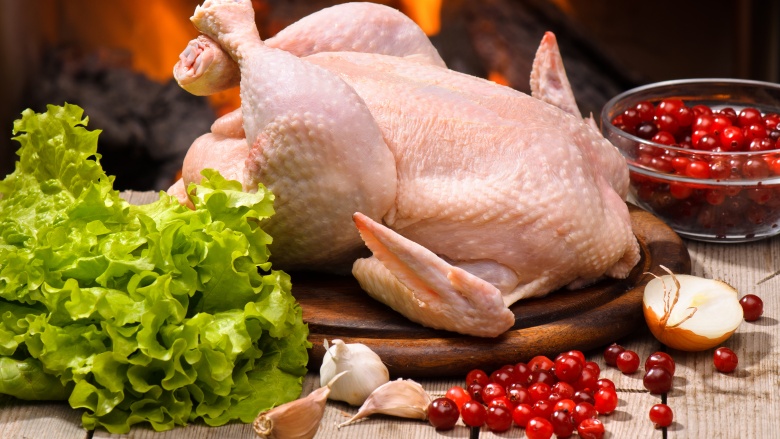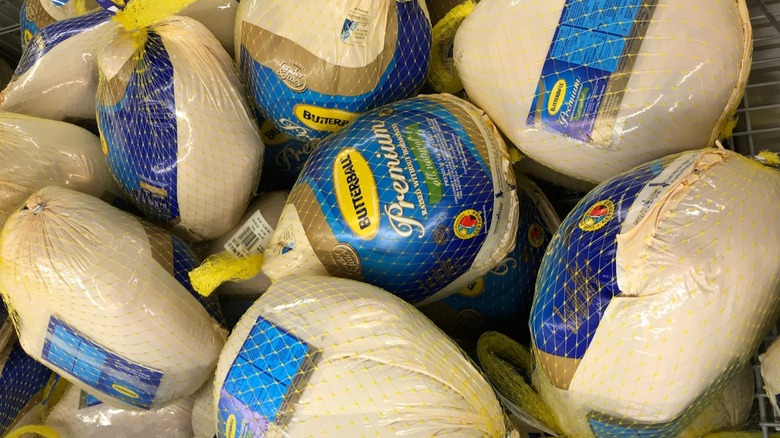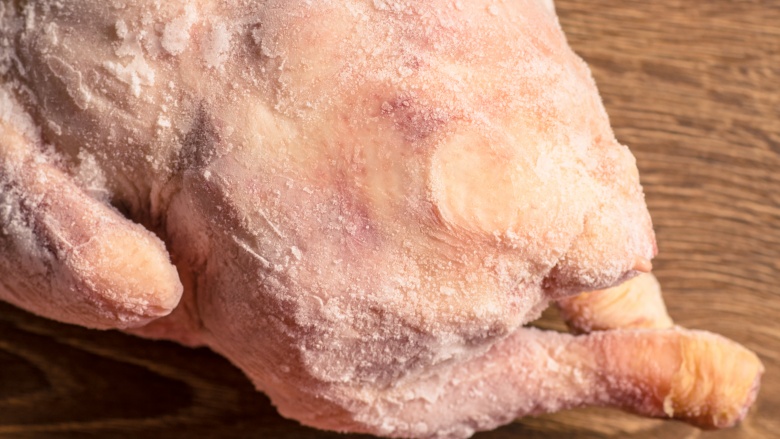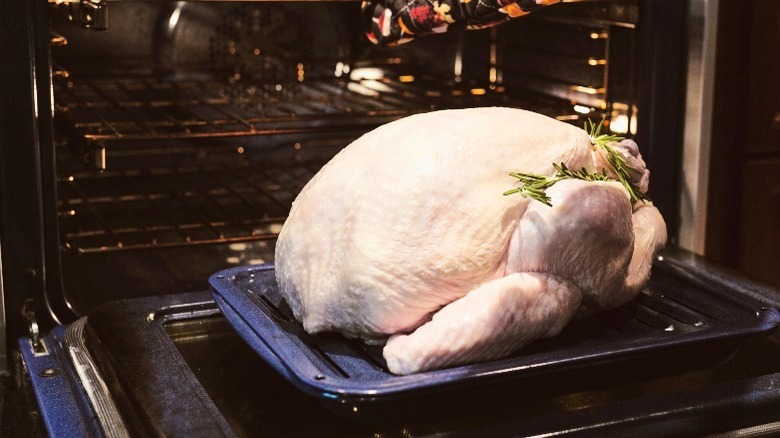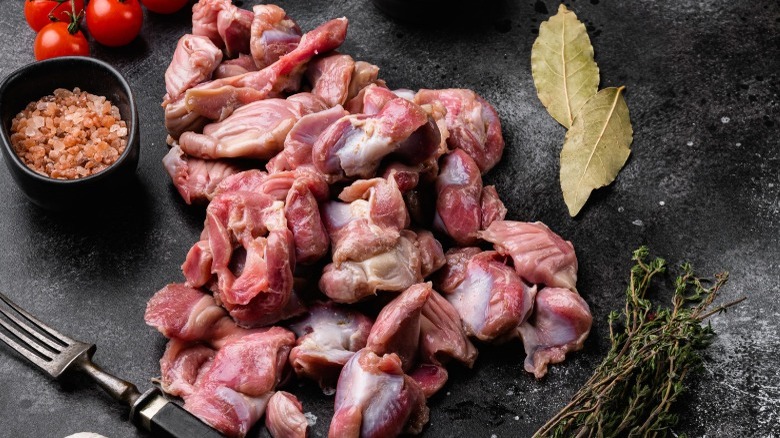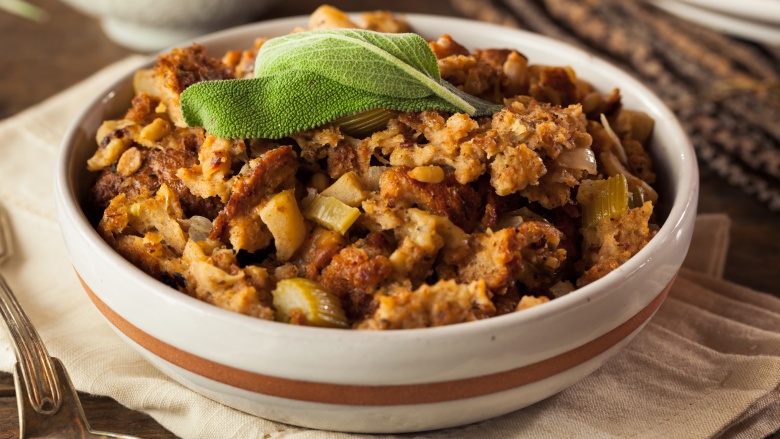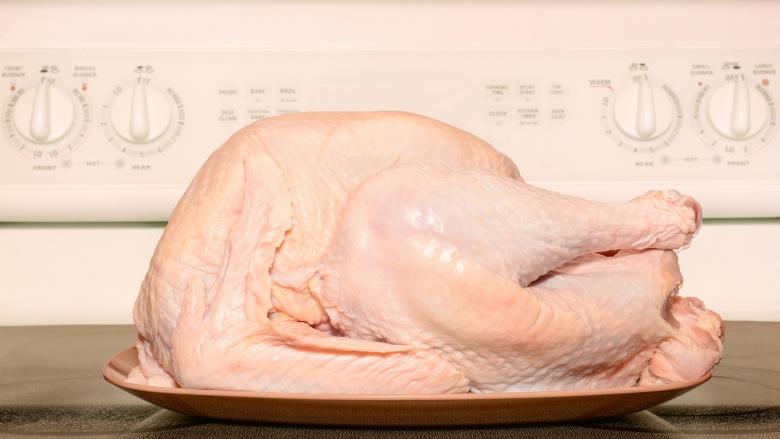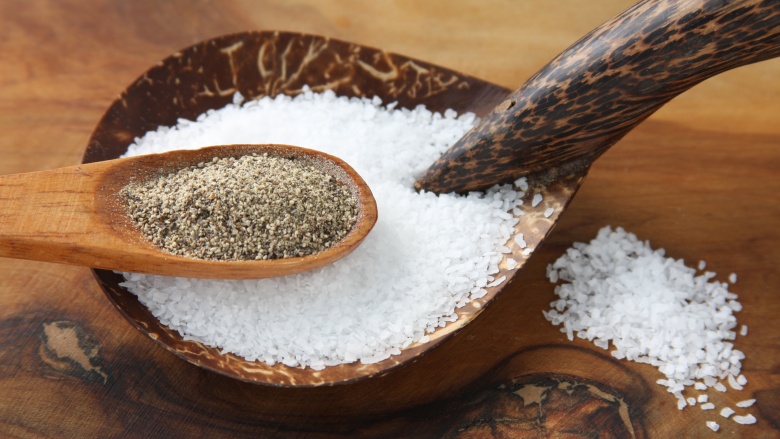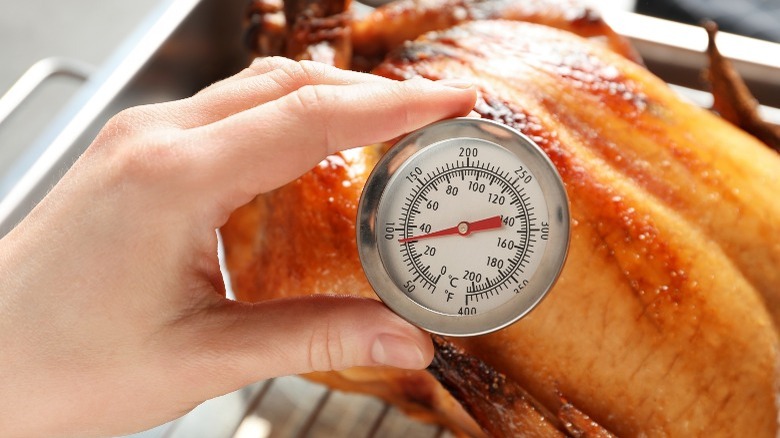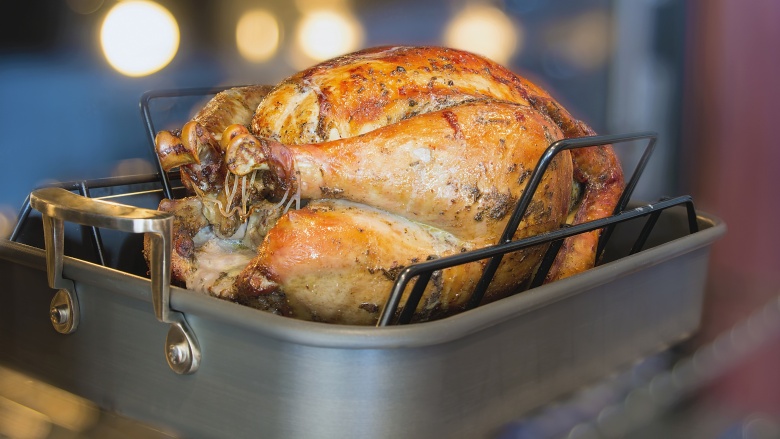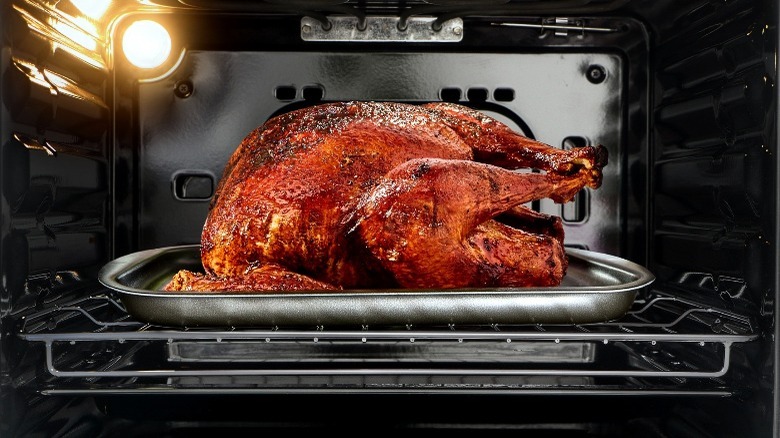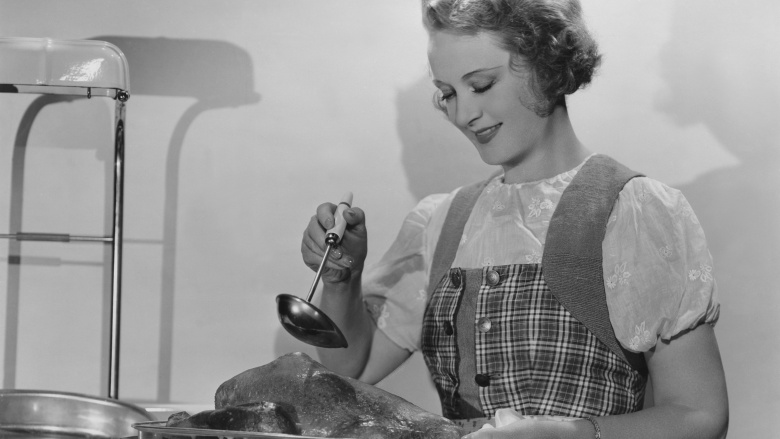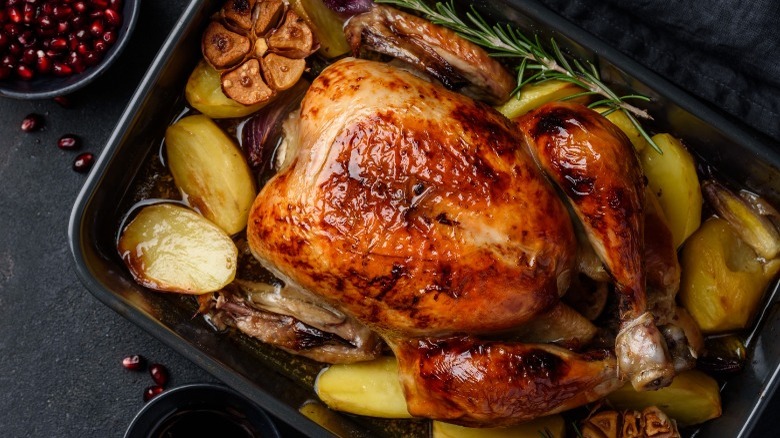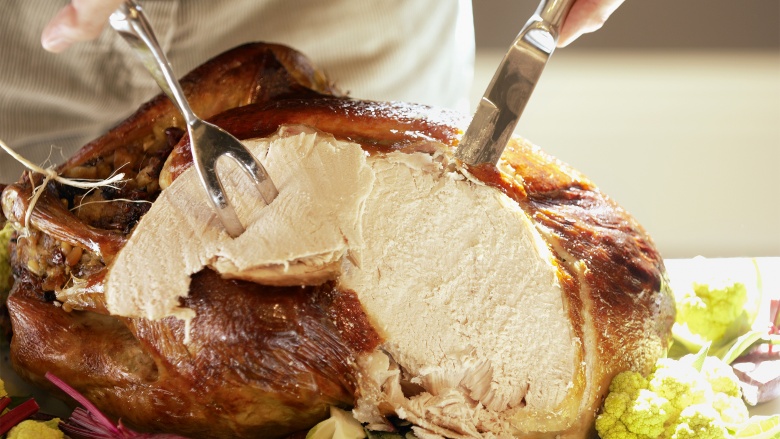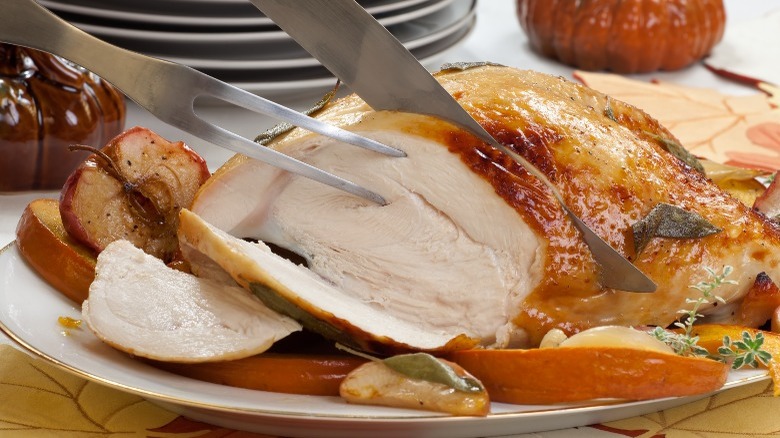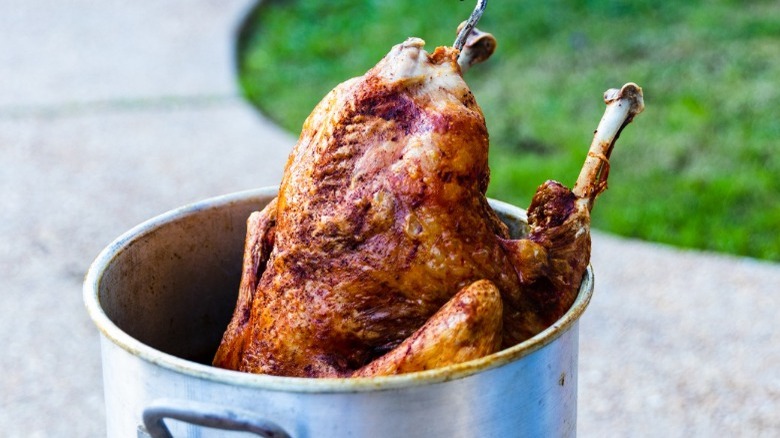16 Mistakes You're Making When Cooking Thanksgiving Turkey
With cooler air, decorative gourds around every bend, and a plethora of woolly coats in sight, November marks the beginning of the holiday season in the U.S. Thanksgiving conjures up images of family gatherings, sweet seasonal pies, and picture-perfect turkeys straight from the oven — if only that last item were as easy to make into a reality as movies and television would have you believe!
Being tasked with preparing this big autumn feast also means accepting responsibility for producing a 15-pound, golden-brown-on-the-outside, impossibly-juicy-on-the-inside turkey that everyone can ooh and aah about. That's a lot of pressure. Whether it's your first time or your tenth time roasting a bird this big, the job is rife with challenges. Luckily, when you do it right, you and your guests are rewarded with dreamy turkey meat that prompts the loosening of belt buckles and halfhearted claims about being "too full" for dessert (This isn't true. There's always room for dessert).
Between choosing your seasonal turkey and prepping it to roasting and carving, you'd be just as happy if someone else volunteered for the gig. Just kidding! Cooking Thanksgiving turkey is fun and rewarding, and it's a privilege to be cho- ... yada yada yada. To help you produce delicious results on the big day without losing your mind, here is a list of common mistakes to avoid when dealing with this finicky bird.
1. Not buying your turkey at the right time
If you're buying frozen turkey like many people do, you can bring yours home up to two weeks in advance and keep it frozen. However, if you opt for a fresh turkey, you'll lose the convenience of buying that far ahead. With this option, you'll want to wait until closer to cooking time so the bird doesn't spoil. Even so, be sure to reserve one at least two weeks before you need it so you know you won't be left empty-handed. For a cream-of-the-crop turkey from a place like Heritage Foods USA, a gourmet meat and poultry purveyor, expect to place your order about one month in advance. While turkeys are plentiful during other times of the year, demand always seems to increase significantly in November. Plan ahead to reduce turkey-induced stress.
2. Not buying the right turkey
They may look similar in the grocery store, but not all turkeys are created equal. Depending on your meal, you may fall for the temptation of simply grabbing the cheapest bird when what you need is something a little more specific. For example, buying a fresh rather than frozen turkey can save you time and trouble in the kitchen, but frozen turkeys can be stored for longer before cooking. Going into the turkey hunt with an idea of what you're aiming for is key in getting a bird that'll fly when it hits the table.
Sizing is always a biggie. Butterball advises two pounds of meat per adult serving and one pound per child serving. So a turkey serving four adults (eight pounds of meat) and three children (three pounds) should be at least 11 pounds total, plus a little for leftovers.
Sometimes, the allure of a cheaply priced turkey can lead you to buy an overly large bird for your occasion. Keep in mind that Butterball also advises one day of thawing for every four pounds of meat if you choose a frozen turkey. This can drastically change your prep time. Who knew cooking a turkey could be so scientific? Apparently, Butterball did. Thank goodness someone is on the (butter) ball.
3. Forgetting to leave time for thawing
Turkeys are big birds, and frozen ones require quite a bit of time to thaw. Don't give yourself a Thanksgiving heart attack by discovering your turkey is frozen solid on Thursday morning. The safest way to thaw meat and poultry is in the refrigerator, but if you can't spare the real estate, you can also leave yours in a vessel of cold water sitting at room temperature in the sink. Depending on the size of your turkey, thawing it in the fridge can require anywhere from one to six days. It isn't hard to skip the annual headache if you're prepared.
4. Roasting a cold turkey
The notion of going cold turkey should only apply when quitting a bad habit. When it comes to roasting a cold turkey, this is one habit you should avoid from the get-go. Once your turkey has defrosted in the fridge for one day per four pounds of meat and you're ready to start meal prep, you can bring your turkey out of cold storage an hour before roasting to bring it up to room temperature. This will ensure even roasting all around.
So what if your turkey is still cold — or worse, partially frozen — when the big roasting day arrives? Cold-water thawing can help. Submerging your still-wrapped turkey in cold water will slowly bring it down to a workable temperature. Remember to change the water every 30 minutes to make sure it stays cold, as room temperature water is a food safety no-no. With 30 minutes of thawing for every pound of turkey, you may have a long task ahead of you, but the alternative is a birdless holiday. Make your decision wisely.
If you do end up with a rock-hard frozen turkey and a house full of hungry people, you can cook a turkey directly from frozen in a 325-degree oven. However, it's not going to turn out nearly as delicious as a properly thawed and tempered bird (via Williams Sonoma).
5. Forgetting to take out the giblets
If you're new to turkey cooking, you may not realize that the cavity of the bird can hold secret treasures — namely, the giblets. This is a giggle-inducing word that means the neck, heart, liver, and gizzard of the bird, all of which can be used in various dishes to enhance your feast. They require separate attention, and simply cooking the bird with its bits and bobs left inside isn't advisable. To make sure you get things square with your giblets, check inside the bird's cavity. Depending on the packaging, they may be in a small, paper-wrapped packet or plastic bag inside. Accidentally cooking them in their wrapping can add hazardous chemicals to your turkey, ruining the whole meal (via Williams Sonoma). It's always worth checking inside the bird to make sure you don't make a costly mistake.
While you can just toss out the giblets if they gross you out, there are many delicious ways to use them. Two classic preparations are using the giblets to flavor gravy or mixing the liver with your stuffing.
6. Actually stuffing your bird with stuffing
While the name suggests that it should be cooked inside the turkey, stuffing should actually be prepared separately and not in the cavity. Your turkey is safe to consume once the internal temperature has reached 165 degrees Fahrenheit, but there's no surefire way of knowing if the turkey-juiced stuffing has reached that temp as well. Avoid the food hazard. Bake your stuffing outside of the bird instead of in. As a bonus, your stuffing definitely won't be soggy; it'll be fully cooked, deliciously crispy at the edges, and tender in the center.
7. Not drying the turkey completely
As with most meats and poultry, a crisp, evenly browned crust on your turkey is the Platonic ideal. In order to achieve this deeply caramelized skin (and decidedly un-soggy meat), it's crucial that you dry your turkey thoroughly from the inside out. Any remaining moisture interacts with the heat and creates steam instead of browning beautifully. Use clean, dry paper towels to absorb any excess droplets, and you'll find yourself on your way to Insta-ready turkey for Thanksgiving Day.
8. Not seasoning the turkey properly
Any self-respecting chef will extol the virtues of seasoning well. Bland turkey is almost as bad as dry turkey. To keep yourself from becoming the victim of a turkey that looks good but tastes blah, remember to season your bird thoroughly — on the inside, too. Start with basic kosher salt and freshly ground black pepper on the outside and in the cavity, then follow your palate for further enhancing the flavors from the inside. While you don't want to risk cooking stuffing inside your turkey for fear of foodborne illnesses, you still want to infuse the meat with aromatics such as herbs and spices.
9. Skipping the meat thermometer
How do you know for sure when your turkey is has fully cooked? The myth of juices running clear is just that — a myth. Turkey is one meal for which using all the tools at your disposal is not only advisable, it's critical. After all the prep work involved in getting the feast ready, the last thing you want is an unservable bird due to improper cooking.
Luckily, a meat thermometer is just the gadget to save you from such a misstep. Meat thermometers are the most accurate tool for measuring the internal temperature of all parts of your turkey. These handy tools are recommended by both the National Turkey Association and the USDA for accurate readings to ensure doneness and food safety. The best meat thermometers can be calibrated for greater accuracy and can give instant readings. It's not only a helpful tool for making sure you've cooked your bird the way you intended to. It's also a necessary instrument for determining whether the turkey is safe for consumption.
Check the turkey's temperature a few times during the cooking process to monitor its doneness. In order to make sure you get an accurate reading, check the thickest part of the breast, the inner wing, and the deepest section of the thigh. Don't rely on the pop-up timer your turkey might have in its breast; those are set to go off at too high a temperature and your bird will be dry (via Huffpost).
10. Not using a roasting rack
Plop your prepped turkey into a roasting pan, transfer it to the oven, and wait for the good smells. That's it, right? Nope. You want to make sure you place your turkey on a rack that fits inside the pan. Doing so helps you avoid the sad mess of burnt turkey skin and aridly dry meat — not to mention the need to disassemble your smoke alarm. Oh, there will be smoke if you skip the rack. This roasting rack from the people who bring you the Thanksgiving Day Parade is a classic that's both effective and affordable.
11. Roasting the turkey at the wrong temperature
Roasting at the optimal temperature is the most important element of cooking a turkey. The size will determine how long the bird cooks, but different roasting temperatures can drastically affect the result as well. Knowing how to gauge the right temperature for your oven from the get-go is your best bet for a fantastic Thanksgiving for one and all.
Because turkeys are a mix of dark and light meat, there's a trick to making sure both cook properly. Per ThermoBlog, the best technique is roasting your turkey at two different temperatures. Start roasting at 450 for an hour, then reduce the temperature to 325 until the entire bird is finished cooking. A meat thermometer will help you gauge internal temperature for doneness. Though ThermoBlog recommends 157 Fahrenheit for finished breast meat, Cook's Illustrated contends that breast meat should be 165 degrees and thigh meat between 170 and 175 at its thickest spot for safe consumption.
12. Basting your turkey
Sure we've all seen characterizations of 1950s housewives meticulously basting their turkeys, but that doesn't mean you should take your cooking cues from these media images. Frequently opening the oven to baste your turkey means letting heat escape. When you're aiming for efficient, even cooking, this is the last thing you want. Using the pan drippings to baste your meat theoretically keeps it moist, but it actually just reincorporates moisture into the skin you worked so hard to dry, making it a soggy mess.
13. Letting the turkey get too hot
Aside from burning it to a crisp, letting your turkey get too hot in an attempt to cook it safely and completely comes with the risk of drying out the bird to the point of a rubbery, jerky-like texture. If you cook at too high a temperature, there's also a chance you'll overcook one part of the bird while undercooking another, or end up with burnt skin and unfinished meat, which is as gross as it sounds. This means heat control is crucial in achieving turkey cooking supremacy. It's no game hen, this colossal beast of the feast, and too much heat applied to your fowl is a sure way to ruin the festivities.
So what exactly does "too hot" mean? According to the USDA, 165 Fahrenheit is the magic number for safety. Anything more, and you risk drying out your bird. Keeping your turkey warm for too long after it's cooked is also a one-way ticket to a dried-out bird. To avoid unintentionally serving your guests a platter of turkey jerky, cook it to precisely 165 and then serve it quickly or cool it down for later reheating.
14. Not allowing your turkey to rest before carving
Even if you and your guests are eager to eat, set the finished turkey aside for 10-15 minutes before carving it. The wait time will make dinner all the more delicious. This resting period allows the released juices inside the turkey to absorb back into the meat, making it tender and juicy. Once you go to carve, you'll happily discover that the flavorful juices are trapped in the turkey meat instead of splattered on the platter.
15. Butchering your turkey to oblivion
Unless you intend on serving the entire bird all at once, slicing the whole thing up as soon as it's cooked can dry out areas that would otherwise remain moist until ready to be eaten. The Daily Meal suggests leaving the unneeded meat on the bone so you can use the leftovers to their best potential for next-day sandwiches and hearty soups. Those dishes deserve the best of the bird as much as the main meal does.
To prevent chalky, dry turkey, take inventory of what you'll need before you start slicing. If you're feeding mostly dark meat eaters, remove the legs and carve them before you move on to the breast meat. A sharp knife makes easy and accurate work of cutting the breast meat away from the bone. For removing white meat from the breast, follow the contours of the bones as you cut and pull the meat away with your hands if necessary. Once the meat is free of the bird, cut the breast into servable slices, using the direction of the fibers as a cutting guide. This sort of civilized carving will give you the best results for bringing satisfying servings to the holiday table.
16. Using the wrong amount of oil when frying
When frying a turkey, its critical to use the right amount of oil. Using too much creates a fire hazard you don't want to risk. The proper process for measuring your oil, according to the National Turkey Federation, is to insert your turkey into the basket of your turkey fryer and place it in the pot. Fill the pot with water until it comes to one to two inches above the turkey. Take the turkey out and use a ruler to measure the distance from the water's surface to the top of the pot. This will tell you how high to fill the fryer with oil before inserting the turkey. Be sure to dry out your pot thoroughly before adding the oil.
In addition to the quantity of oil used, safe turkey frying means only frying a fully thawed bird (via USA Today). Dropping frozen fowl into a heated fryer will turn ice crystals into steam and cause the oil to overflow or splatter. The online videos that circulate each year should be enough inspiration to follow all the safety rules when it comes to frying up the main dish in your holiday feast.

